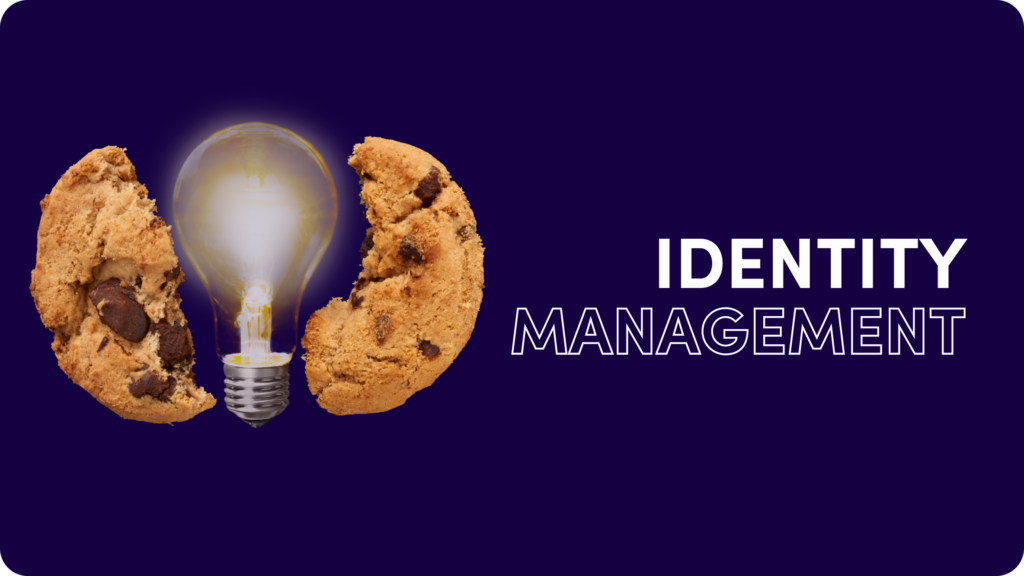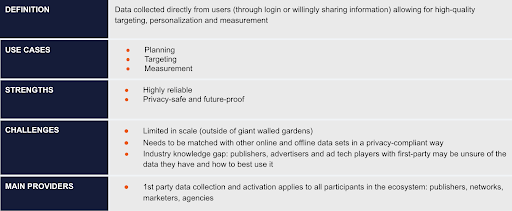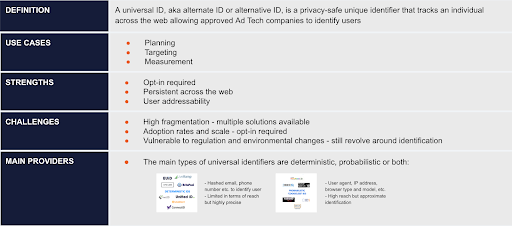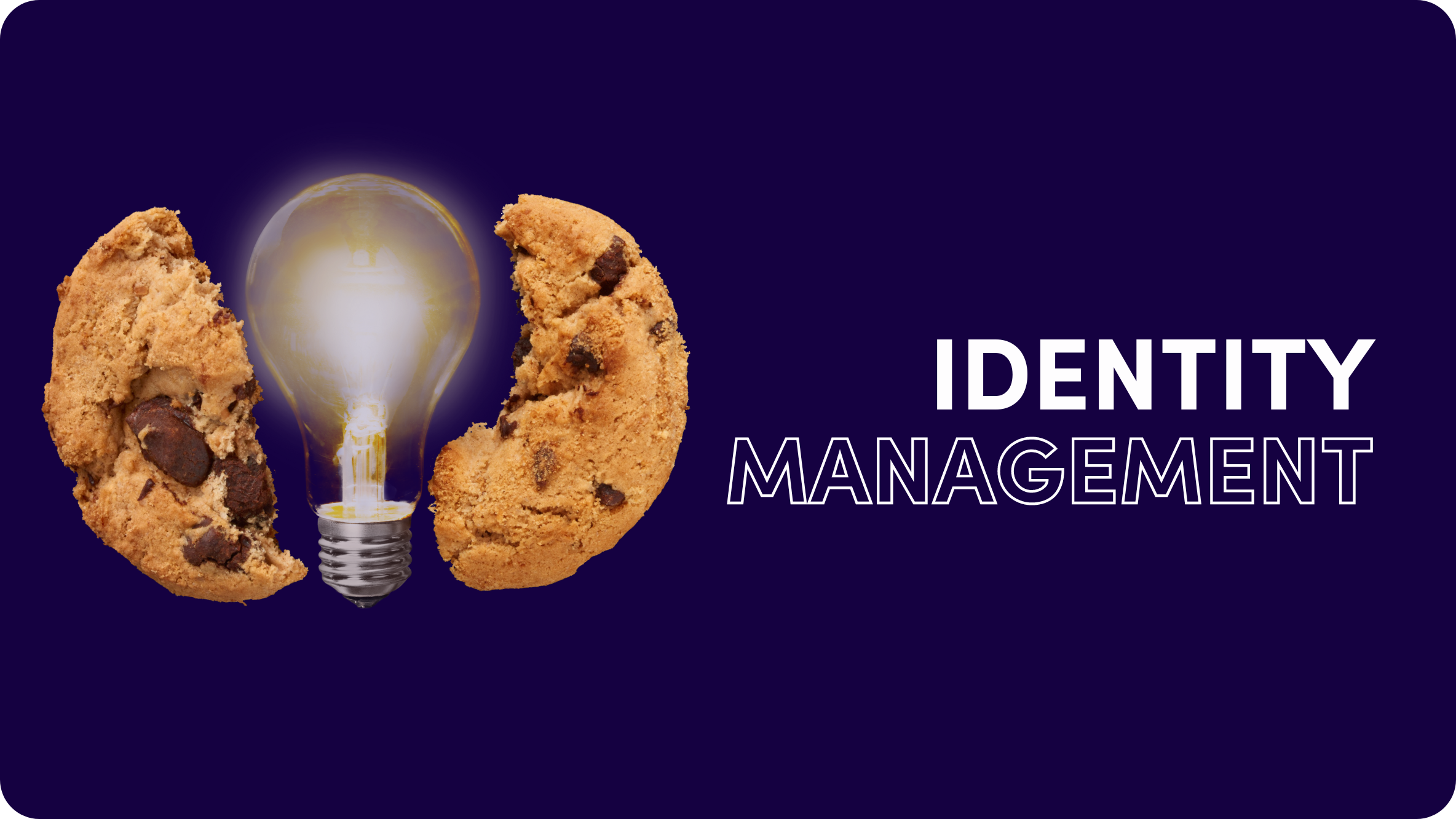Navigating the Cookieless Era Part 4: Exploring Identity Management Solutions – First-Party Data, Universal Identifiers, Data Clean Rooms

Next up in our Navigating the Cookieless Era series, we focus on identity management solutions, namely first-party data, universal identifiers, and data clean rooms. If you’re joining us now, our first three blog posts help set the scene: It’s Not About Cookies, It’s About Profiling, Facing the User Identification Problem, and Rethinking Media Planning with Contextual Targeting and AI.
With over 80 solutions on the market today, confusion reigns about which ones to test and implement. Let’s explore the key solutions for user identity management in turn.
First-Party Data Activation
Arguably the most important concept in user identity management is first-party data. Having a direct relationship with users, who either log onto a service with their user information or share their information willingly, is the most reliable and future-proof way of conducting business.
This applies to all participants in the ecosystem: publishers, networks, marketers, and agencies. Everyone should be able to explain to consumers why they are participating in the value chain and convince at least some of them to interact directly.
First-party user data can also be shared downstream if the users agree to it. Publishers who know the gender and age of their subscribers might choose to share the two attributes rather than a hashed email, to enable targeting while preserving privacy.
While first-party data is particularly reliable, it also comes with its challenges as a user identity management solution, including:
- Limited scale
- Often needs to be matched with other data sets
- Without the right resources, it can be tricky to collect, understand, and use
First-party data cheat sheet

Universal Identifiers
Universal Identifiers aim to replicate what third-party cookies do (cross-site tracking and profiling) in privacy-compliant ways. They are also called Universal IDs, One-to-One Identifiers, or Distributed ID Systems. Examples include the Trade Desk’s Unified ID 2.0, LiveRamp’s Authenticated Traffic Solution, or the ID5 ID.
A Universal ID is a single identifier that provides approved partners across the supply chain with a shared identity for a user. This can be done by leveraging probabilistic user attributes (user browser and other data that roughly identifies users), or hashed and encrypted email addresses.
These identifiers are more secure and privacy-compliant than third-party cookies because only pre-approved partners can decrypt them, and they can only be used with user consent.
Additionally, Universal Identifiers are standardized, meaning they can be ‘read’ by all participating partners, thus bypassing the cookie-syncing process and avoiding data loss.
While they promise to bring many advantages to the entire ecosystem, from publishers to users, Universal Identifiers also face challenges in user identity management, including market fragmentation, scale, and vulnerability to regulation and environmental changes. Collection of consent signals at scale requires proper management, and publishers would need to accept the inclusion of their readers in the identifier. Indeed, a key to the success of these identifiers will be mass adoption.
At Outbrain, we support cross-industry and standardized solutions for addressability post-cookie, including the sharing of Universal Identifiers.
Universal Identifiers cheat sheet

Data Clean Rooms
The last identity management solution we will cover is data clean rooms. Data clean rooms are platforms that enable companies to share anonymized aggregated data (or data organized into cohorts) with advertisers, without it leaving their control and without violating user privacy.
Data clean rooms help advertisers measure and analyze campaign performance across multiple anonymized data sets, informing marketing strategy and audience optimization. For example, Amazon Marketing Cloud is a data clean room that allows brands to access anonymized, aggregated consumer data from Amazon and its subsidiary brands, such as Twitch.
Currently, there are several data clean room providers on the market, including Snowflake, Hab, LiveRamp, and InfoSum. Amazon also recently released AWS Clean Rooms, which can be used by any business to create their own clean room (for example, a media owner could create a clean room and match their data with their advertising partners). There is still confusion around how exactly data clean rooms can best be used for marketing. Therefore, brands and agencies have not yet adopted them on a wide scale.
Data clean rooms are more than just a replacement for cross-site targeted advertising and measurement provided by third-party cookies. They unlock collaboration between any two parties that may not have worked together in the past (or even two unrelated companies, with similar audiences), and they open a new monetization opportunity for publishers. In the words of Michael Schon, EVP of Marketing Solutions at Neustar, we need to start looking at data clean rooms for the “new value they’re actually bringing to the table: privacy-preserving data collaboration, audience building and new breakthroughs in marketing analytics.”
Data clean rooms are tricky to implement and demand extensive resources. For this reason, marketers considering a data clean room for identity management solutions should explore how it can integrate with their existing marketing tech stack and drive forward their strategy.
Data clean rooms cheat sheet

In the next chapter of this series, we will take a closer look at What is Cohort Marketing? Google Privacy Sandbox & Seller-Defined Audiences.
FAQs
Identity management vs Privileged identity management: What is the difference?
Identity management involves managing and securing digital identities, including user authentication and access control. Privileged identity management focuses specifically on securing privileged accounts, such as those with administrative privileges, through strict access controls, monitoring, and auditing, to prevent unauthorized access and mitigate security risks within organizations.
What is Identity and Access Management (IAM)?
Identity and Access Management (IAM) is a framework for managing digital identities and controlling access to resources within an organization. It includes processes and technologies for user authentication, authorization, and permissions management, ensuring that the right individuals have appropriate access to the right resources at the right time.
What is first-party data example?
First-party data refers to information collected directly from individuals by an organization. An example is data gathered through website interactions, such as user registrations, purchase history, and website behavior, which the organization owns and controls.
What is Universal Unique Identifier and how can it help publishers?
A Universal Unique Identifier (UUID) is a 128-bit identifier used to uniquely identify information in computer systems. Publishers can use UUIDs to track user interactions across devices and platforms without relying on cookies, enabling more accurate audience segmentation and targeting. This helps publishers deliver personalized content and ads to users while maintaining privacy and compliance with data protection regulations.




